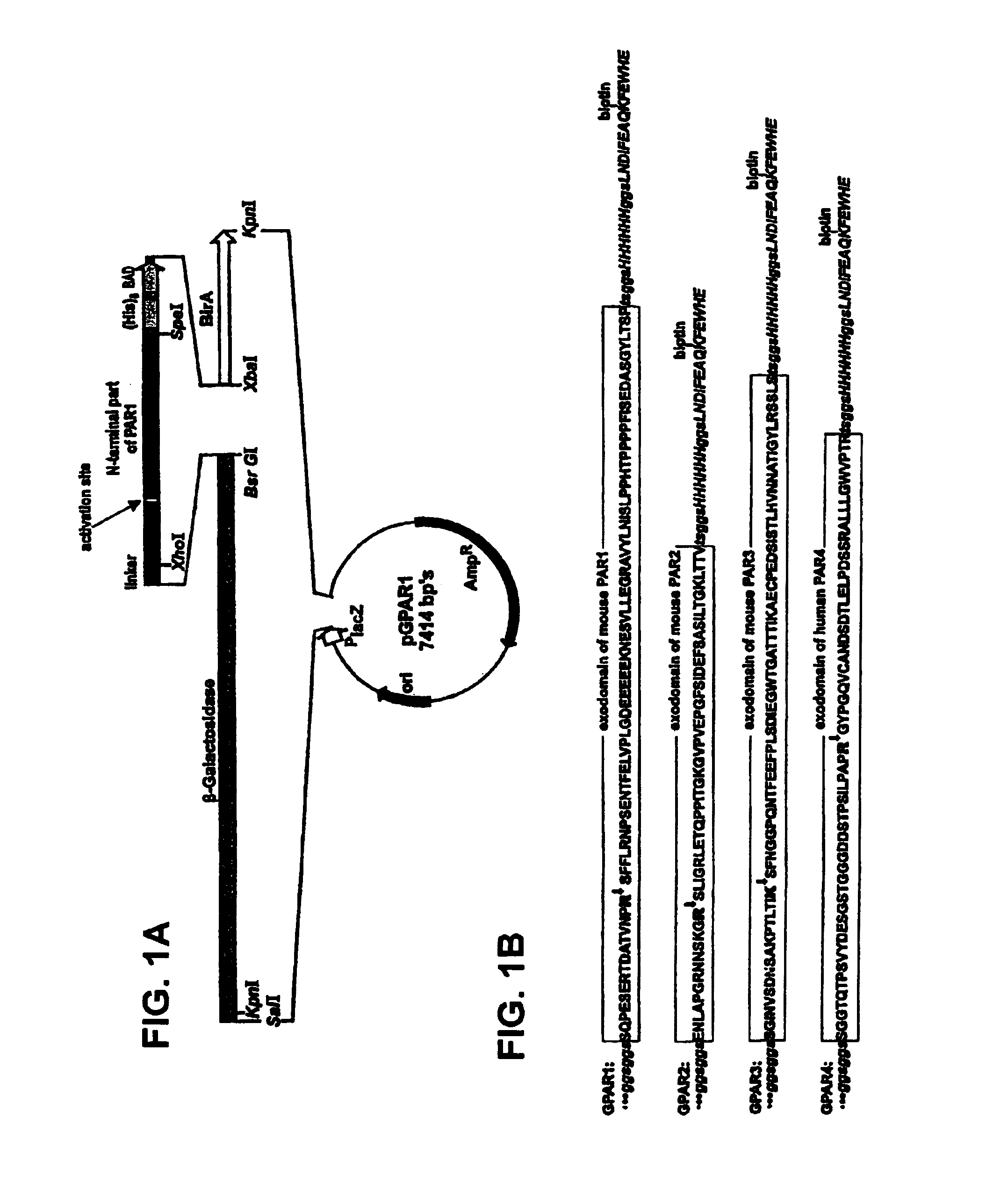Protease-activated receptor (par) modulator assays
a protease activator and assay technology, applied in the field of protease activator assays, can solve the problems insensitive, cumbersome methods, etc., and achieve the effect of not being particularly amenable to high-throughput methodologies
- Summary
- Abstract
- Description
- Claims
- Application Information
AI Technical Summary
Problems solved by technology
Method used
Image
Examples
example 1
Detection of PAR-1 Cleaving Protease
[0067]This example describes the preparation of a galactosidase-PAR1 (GPAR1) as a recombinant protein obtained by fusion of β-galactosidase, the extracellular domain of PAR-1, a His6-tag, and a biotin acceptor domain for in vivo biotinylation. Cleavage of the GPAR-1 fusion protein immobilized to streptavidin leads to the release of active soluble β-galactosidase that provides a means of monitoring proteases able to cleave the extracellular domain of PAR-1. Used as an immobilized substrate, the GPAR-1 fusion protein allows for the first time the detection of thrombin in the subpicomolar range.
Strains and Media
[0068]E. coli strain SCS110 (Stratagene, La Jolla, Calif., USA) was used for propagating recombinant plasmids. Recombinant GPAR-1 was expressed in either the E. coli strain M15[pREP4] (Qiagen), SCS110 or XL1-Blue MR (Stratagene). E. coli cells were grown in 2×YT medium, supplemented with 100 μg / ml ampicillin (Sambrook et al. (1989) Molecular C...
example 2
Specificity of GPAR1 Assay and Identification of PAR1 Activators and Inactivators
[0094]In order to show that the thrombin cleavage took place at its expected cleavage site, a mutant form of GPAR1 was generated, where an R45S mutation prevents cleavage by trypsin-like serine proteases. The expression vectors for mutant GPAR1 were generated by excision of the PAR1 fragment from pGPAR1 (see Example 1) and replacement with a mutant PAR1 encoding DNA fragment. The mutant PAR1 construct carried a point mutation at the codon for the first amino acid residue of the activation site, leading to an incorporation of serine instead of arginine, thus rendering this site resistant to cleavage by trypsin-like serine proteases, including thrombin. The mutant PAR1 encoding fragment was prepared from pBSmThR using 5′-CTCATGTACAGTGGAGGTTCAGGAGGCTCGAGCCAGCCAGAA TCAGAGAGGACAGATGCTACGGTGAACCCCAGCTCATTCTTTCTAAGGAATC-3′ (SEQ ID NO:8) and 5′-GAGAGAACTAGTGGGGCTGGTCAGATATCCGGAG-3′ (SEQ ID NO:4) as primers. Exc...
example 3
Identification of PAR-2 Activators and Inactivators
[0104]This example describes the preparation of a galactosidase-PAR2 (GPAR2) fusion protein and its use in assays designed to detect PAR2 activators and inactivators.
[0105]The expression vectors for GPAR-2 or GPAR2R34S were prepared by excision of the PAR1 fragment from pGPAR1 with Xhol and Spel (see Example 1) and replacement of the excised fragment with a DNA fragment encoding the mouse PAR-2 extracellular domain or its activation site mutant. The mouse PAR2 exodomain coding sequence was prepared by PCR using the synthetic DNA oligonucleotides 5′-CACACATGTACAGTGGAGGTTCAGGCGGCT CGAGCGAGAACCTTGCACCGGGACGCAACAACAGTAAAGGAAGAAGTCTTATTGGCAG ATTAGAAACCCAGCCTCCAATCACTG-3′ (SEQ ID NO:9) AND 5′-CACACAACTAGTGACC GTGGTCAGCTTCCCGGTGAGGATGGACGCAGAGAACTCATCGATGGAAAAGCCTGGTT CTACCGGAACCCCTTTCCCAGTGATTGGAGGCTGGGTT-3′ (SEQ ID NO:10) as templates. The PAR2 activation site mutant was prepared in the same way but instead of the oligonucleotide SEQ ID ...
PUM
| Property | Measurement | Unit |
|---|---|---|
| volume | aaaaa | aaaaa |
| pH | aaaaa | aaaaa |
| pH | aaaaa | aaaaa |
Abstract
Description
Claims
Application Information
 Login to View More
Login to View More - R&D
- Intellectual Property
- Life Sciences
- Materials
- Tech Scout
- Unparalleled Data Quality
- Higher Quality Content
- 60% Fewer Hallucinations
Browse by: Latest US Patents, China's latest patents, Technical Efficacy Thesaurus, Application Domain, Technology Topic, Popular Technical Reports.
© 2025 PatSnap. All rights reserved.Legal|Privacy policy|Modern Slavery Act Transparency Statement|Sitemap|About US| Contact US: help@patsnap.com

